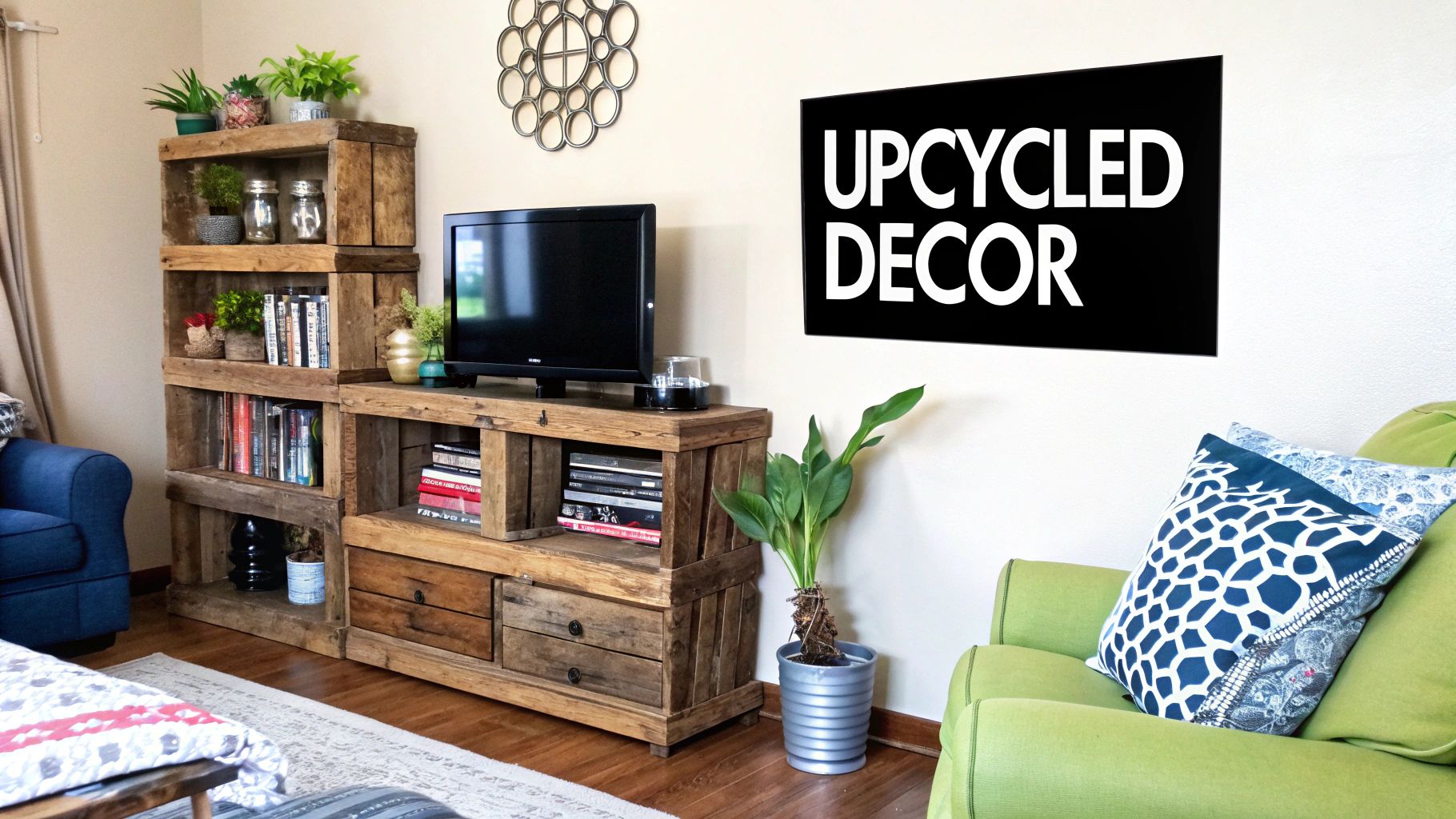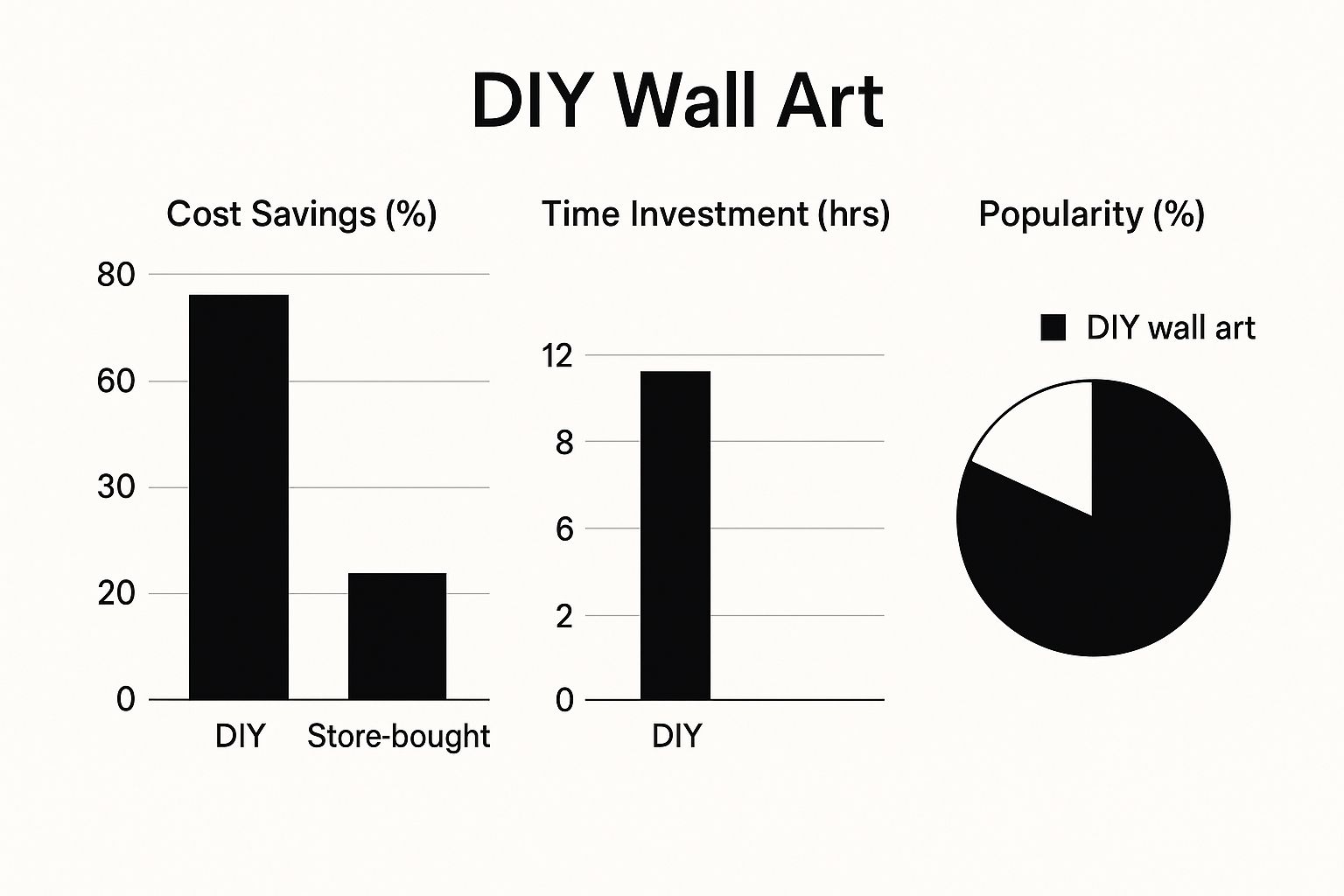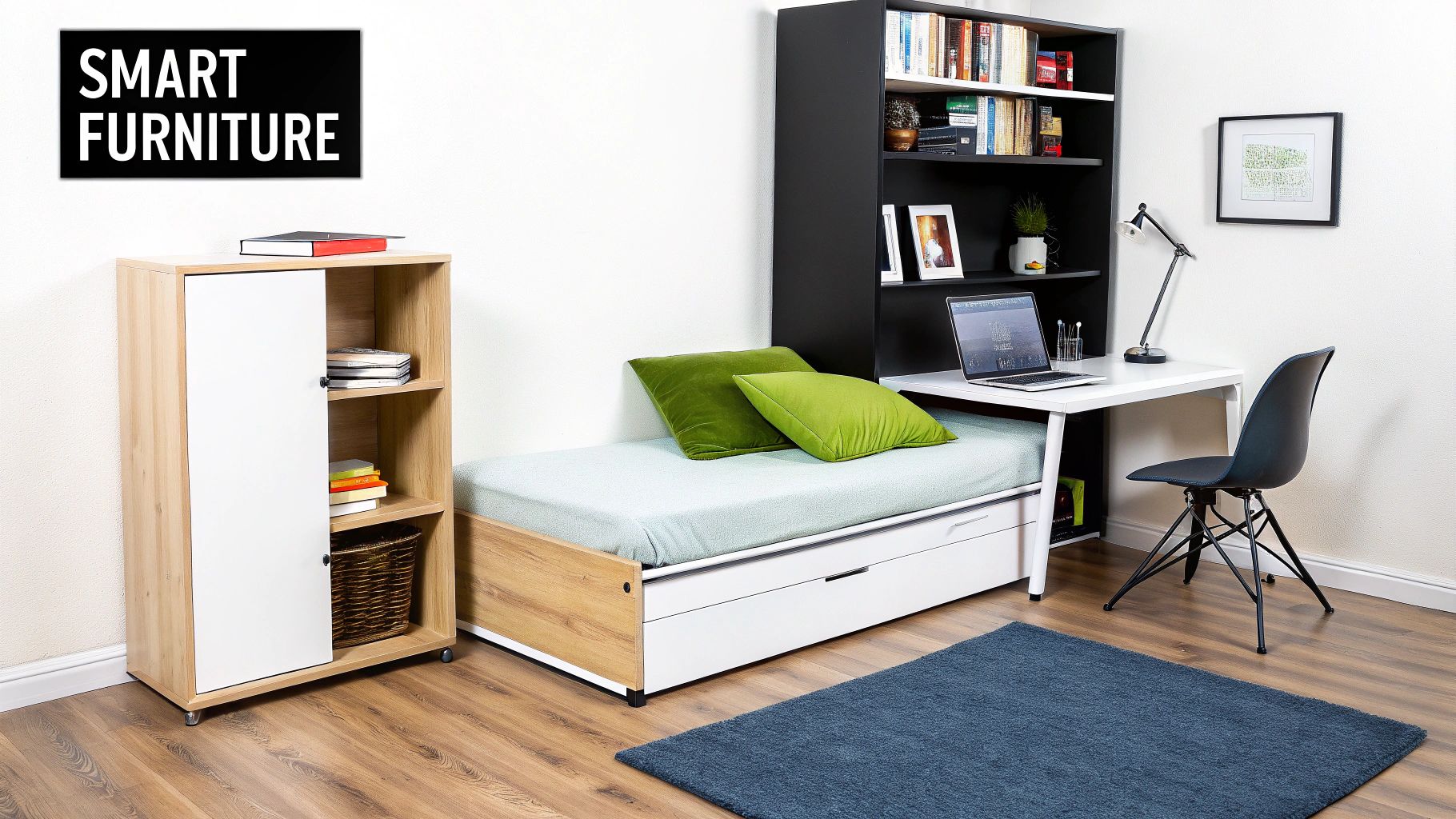
Unique Home Decor Ideas to Redefine Your Space
Share
Finding truly unique home decor ideas isn't about mindlessly copying trends. It's about figuring out how to translate your personality, your history, and your passions into a space that feels completely, authentically you. Think of your home as a canvas for your life story, where every object has a little bit of meaning behind it.
How to Discover Your Authentic Decorating Style

Before you even think about shopping, the most important thing you can do is define what "unique" actually looks like for you. This goes way beyond just pinning beautiful rooms on Pinterest. It's about getting to the core of your personal aesthetic.
So, instead of trying to shoehorn yourself into a label like "boho" or "industrial," let's uncover a look that's all your own. The funny thing is, your authentic style is probably hiding in plain sight—in your closet, on your bookshelf, and in your camera roll.
Look Inward for Inspiration
Your home should be a direct reflection of your life and the things you love. The best way to start is by looking at the things you already love, because they hold some powerful clues to your decorating DNA. Taking the time for this self-discovery phase makes sure every piece you choose later feels deliberate and personal.
Have a look through these personal treasure troves:
- Your Wardrobe: Are you all about neutral colors and classic, simple textures? Or is your closet bursting with bold patterns and vibrant colors? The fabrics and colors you choose to wear can translate perfectly into home textiles like pillows, throws, and rugs.
- Your Travels: Picture a place that made you feel truly alive. Was it the rustic, sun-baked charm of a Tuscan villa, or maybe the sleek, clean lines of a modern Tokyo apartment? Souvenirs, photographs, and even the color palettes from your favorite trips can become the building blocks of a room.
- Your Hobbies: If you have a passion for gardening, that could inspire a biophilic design filled with plants and natural materials. Or, if you're a book lover, why not make a dedicated library wall the stunning focal point of a room?
Build a Practical Mood Board
Once you’ve gathered some of these personal, inspirational elements, it’s time to give them a tangible direction. A mood board is so much more than a collage of pretty pictures; it’s a practical tool that keeps your vision focused and cohesive. And while digital tools like Pinterest are great for gathering ideas, I find that creating a physical board can be far more powerful.
A well-curated mood board acts as your design compass. It prevents impulse buys and ensures that every new item, from a flea market find to a new sofa, aligns with the authentic story you want your home to tell.
Start gathering physical samples—things you can touch and feel, like fabric swatches, paint chips, and clippings from magazines. Arrange and rearrange them until the whole collection just feels right. This tactile process really helps you see how different textures and colors play off each other in a way you can't get from a screen.
Pay close attention to the overall feeling that starts to emerge. Is it calm and serene? Or is it energetic and eclectic? That feeling is the essence of your style. Once you’ve nailed that down, you can dive deeper into specific elements. For instance, you could explore stunning paint colors that will revolutionize your bedroom decor to perfectly match your new aesthetic. Putting in this foundational work makes every decision that follows so much easier and more authentic.
Where to Find One-of-a-Kind Decor Pieces
If you want a home with real soul, you've got to step away from the big-box stores. The real magic happens when you start a treasure hunt in places filled with history and craftsmanship, where every object has a story. This isn't just about collecting things; it's about curating a space that feels like you.
And forget the idea that you need a massive budget. Some of the most incredible, character-defining pieces I've ever found were tucked away in flea markets, antique shops, and estate sales. This is where you unearth gems like architectural salvage—old corbels, anyone?—or vintage textiles with that perfectly aged patina.
Embracing the In-Person Hunt
There’s something truly special about sifting through treasures by hand. The key to not getting overwhelmed at a chaotic flea market or a packed estate sale is having a strategy.
My best advice? Go in with an open mind. I always look for pieces with good "bones"—a beautifully constructed wooden chair that just needs new upholstery, or a set of old drawers that would make a killer entryway console. It’s all about seeing the potential beyond the dust.
The most authentic homes are built, not bought. Curating a collection of vintage and antique finds is a patient, rewarding process. It’s a slow burn that results in a space that’s impossible to replicate.
Don't shy away from items that need a little TLC. A chippy, peeling mantelpiece can become a stunning focal point in a room that doesn't even have a fireplace. I've even used old shutters as captivating wall art more times than I can count.
Navigating the Digital Marketplace
The hunt for unique decor isn't just an offline sport anymore. The internet has blown the doors wide open, giving us direct access to artisans, vintage sellers, and unique makers all over the world.
The numbers don't lie. Online sales in the home decor market have skyrocketed to nearly 48%, a change largely powered by millennials, who make up about 42% of those digital shoppers. You can discover more about home decor market trends on businessresearchinsights.com. This massive shift online has created incredible new avenues for finding those perfect one-of-a-kind pieces.
Here are a few of my go-to digital spots:
- Etsy: This is my first stop for anything handcrafted. You can connect directly with artists to find everything from custom pottery to bespoke light fixtures.
- Chairish: Think of this as a highly curated marketplace for top-tier vintage and antique furniture. It's my secret weapon for finding authenticated, true statement pieces.
- Social Media: Don't sleep on Instagram and Facebook Marketplace. They are goldmines for discovering local artists and furniture flippers. I’ve even commissioned custom art this way for clients who wanted something truly personal.
Looking for Specific Statement Pieces
Sometimes you know exactly what a room is missing—maybe it's the perfect ceramic vessel or a bold, sculptural vase. When you're on a mission for something specific, your search needs to be more focused.
Take vases, for example. The right one can completely elevate a room. Knowing where to look for high-quality, handcrafted options is half the battle. You can get a feel for what’s out there by browsing collections of designer-approved vases that serve as art pieces.
Speaking of art, many people get stuck between making something themselves or buying it. This infographic breaks down the choice between DIY and store-bought wall art.

As you can see, while a DIY project will take some of your time, the cost savings are significant. It’s no wonder it’s such a popular route for homeowners who want to inject a bit of their own personality into their space.
High-Impact DIY Projects for a Truly Custom Look

There's a special kind of pride that comes from pointing to a standout piece in your home and saying, "I made that." Getting your hands dirty with a DIY project is the absolute best way to create a look that's one-of-a-kind. But we're not talking about simple crafts here. High-impact DIY is all about creating professional-quality décor that genuinely becomes a focal point in any room.
These are the projects that make guests stop and ask where you bought something. It's less about macaroni art and more about smart, thoughtful transformations that inject real personality and value into your space. And the best part? You don't need to be a master woodworker to get a polished, impressive finish.
Rethink and Reupholster Found Objects
One of the most satisfying ways to get a unique look is by giving forgotten items a second chance. That thrifted chair with great bones but hopelessly dated fabric? It’s the perfect candidate for a stunning makeover. Reupholstering might sound like a job for the pros, but with a good staple gun, sharp fabric scissors, and a bit of patience, it’s a surprisingly doable project.
Imagine taking a drab, $20 armchair and turning it into a showstopper with a bold, modern velvet or a vibrant botanical print. This is your ticket to introducing high-end fabric patterns into your home for a tiny fraction of what a new custom chair would cost. Just remember to look for pieces with solid frames and interesting shapes—the rest is just cosmetic.
The best DIY projects come from seeing potential where others just see junk. An old, salvaged window frame isn't trash; it's an elegant mirror waiting to happen. Cultivating that mindset is the secret to creating a home that’s a true reflection of you.
Architectural salvage yards are an absolute goldmine for this kind of thing. For example, a vintage six-pane window can be easily turned into a beautiful mirror with some custom-cut glass, adding instant character and bouncing light around an entryway or living room.
Create Your Own Large-Scale Art
Why drop a fortune on generic wall art when you can create a huge abstract piece that perfectly matches your room's color palette? This is one of the most accessible DIY projects out there, but it delivers an incredible amount of impact. All it really takes is a large blank canvas, a few tubes of acrylic paint, and some basic brushes—or even household tools like putty knives for creating texture.
The beauty of abstract art is that there are no rules. Just focus on movement, texture, and how the colors blend together to create a piece that feels dynamic and personal. This is your opportunity to inject an energy into a room that a store-bought print just can’t replicate.
Creative upcycling can also lead to some amazing, unexpected results.
- Textured Book Wall: Gather old, mismatched hardcover books from a thrift shop. Remove the covers and arrange the pages to create a stunning, textured accent wall behind your bed or desk.
- Custom Pendant Lighting: Find a collection of interesting antique glass bottles or jars. With a simple pendant light kit from a hardware store, you can transform them into a custom chandelier over a dining table.
- Elevated Greenery: Don’t just place your plants—display them. A simple but elegant piece like a minimalist Adu plant stand can make your favorite houseplant feel like a curated art installation, tying all your DIY elements together with a clean, professional touch.
Styling Your Unique Finds Like a Pro
You’ve hunted, gathered, and brought home your treasures—now for the really fun part. Styling your unique finds is where the personality of your home truly clicks into place. It’s all about arranging these special objects in a way that feels intentional, balanced, and a direct reflection of you.
This isn't about following a rigid set of rules. Instead, think of it as learning a few core design principles that will help you turn a collection of individual items into a cohesive, captivating story. Let’s walk through how to apply these ideas room by room, making sure every space feels both personal and thoughtfully designed.
Mastering the Art of the Vignette
Think of a vignette as a small, curated story you tell with objects. It could be on a coffee table, a bookshelf, or a console table. The goal here is to create a pocket of visual interest without tipping into clutter. The secret to a really great vignette almost always comes down to variation and balance.
To nail this, focus on a few key things:
- Vary Your Heights: Always place taller items, like a candlestick or a slender vase, toward the back. Then, layer shorter, more substantial objects in front of them. This simple trick instantly creates depth and guides the eye through the entire display.
- Mix Materials and Textures: This is where the magic happens. Combine different finishes to add a layer of complexity. For instance, you could pair a rough, unglazed ceramic pot with a smooth glass paperweight and a stack of worn, vintage books. That contrast is what makes an arrangement feel dynamic and alive.
- Work in Threes (or Fives): There’s a reason designers always talk about grouping items in odd numbers—it just feels more natural and less staged than even-numbered groupings. An arrangement of three distinct objects often strikes that perfect, effortless balance.
Once you get the hang of these small-scale arrangements, you can apply the same principles to bigger areas of your home. It’s the foundation for creating unique home décor ideas that feel curated, not contrived.
A well-styled home feels collected, not decorated. It’s the thoughtful mix of scale, texture, and personal history that prevents an eclectic space from feeling chaotic and instead makes it feel like a genuine extension of its inhabitants.
Creating Focal Points in Key Rooms
Every room needs a clear focal point—that one spot where your eye naturally lands when you walk in. Your unique décor pieces are the perfect candidates for establishing these anchor points, turning an ordinary wall or corner into a real statement.
In the living room, for example, this could be a chippy, salvaged mantelpiece mounted on a blank wall, even if you don't have a fireplace. You can style it with a collection of antique mirrors or casually lean a large piece of abstract art against it for a relaxed, layered look. Suddenly, you have a powerful visual anchor that grounds the entire seating area.
For the bedroom, think beyond the standard headboard. What about mounting a pair of antique shutters or a large, ornate vintage window frame behind the bed? This instantly adds architectural interest and a sense of history, making the bed the undeniable star of the room.
And don't forget the kitchen! Open shelving is the perfect stage for styling. The trick is not to just line up your dishes in a row. Instead, mix your functional items with purely decorative ones—a beautiful stack of ceramic bowls next to a small piece of framed art, a trailing plant, and a vintage copper pot. This balance of beauty and function makes the space feel lived-in and full of character.
To help you get started, here is a quick-reference table with some unique styling concepts for different rooms in your home.
Unique Decor Styling Concepts by Room
This table summarizes a few actionable and unique decor concepts you can adapt for specific rooms in your house, turning everyday spaces into something special.
| Room | Styling Concept | Unique Idea Example |
|---|---|---|
| Living Room | The Asymmetrical Gallery Wall | Mix framed art with unexpected objects like a vintage textile, a small mirror, or antique plates to create a dynamic, personal display. |
| Bedroom | The Layered Headboard | Instead of a single headboard, hang a macrame wall hanging behind a simple wooden frame for added texture and a bohemian feel. |
| Kitchen | The Functional Vignette | On your counter, group a beautiful cutting board, a crock of wooden spoons, a small herb plant, and a bottle of artisan olive oil. |
| Bathroom | The Elevated Essentials | Use a vintage wooden tray to corral pretty soap dispensers, a small vase with a single stem, and a scented candle next to the sink. |
| Entryway | The "First Impression" Console | Style a narrow console table with a striking table lamp, a unique bowl for keys, and a vertically hung mirror to open up the space. |
Think of these as starting points. The best ideas will come from experimenting with the pieces you love and finding what arrangement tells your story best.
Marrying Personal Style with Sustainable Choices

A truly personal home isn't just about what looks good—it's about what feels right. These days, that feeling often comes from making conscious, sustainable choices that reflect your values. And let's be clear: going green doesn't mean sacrificing an ounce of style. If anything, it opens the door to a home that's richer in character and story.
This isn't just a niche trend; it's a significant shift in how we approach design. In fact, around 35% of consumers are now actively looking for decor made from eco-friendly materials, according to market insights from Fortune Business Insights. This growing demand is fueling a wonderful resurgence of artisanal goods that not only look beautiful but also tell a story and lighten our environmental footprint.
Prioritizing Eco-Friendly Materials
The simplest way to start building a more sustainable home is to pay attention to what your decor is made of. You'd be amazed at the texture, warmth, and beauty you can find in natural materials—qualities that mass-produced items often lack.
Look for pieces made from powerful, sustainable alternatives:
- Reclaimed Wood: Not only is it gorgeous, but every piece comes with its own history. It adds instant rustic charm and keeps beautiful old-growth wood out of the landfill.
- Bamboo: It's technically a grass, and it grows incredibly fast, making it a highly renewable resource. It's also surprisingly strong and versatile, perfect for everything from furniture to flooring.
- Cork: Harvested from the bark of cork oak trees without ever cutting them down, cork is a fantastic renewable and biodegradable option. It also happens to be a great natural sound insulator.
Choosing decor made from materials like these infuses your space with natural beauty while supporting a healthier planet.
The Power of Secondhand and Handcrafted Decor
If you want to make a big impact, start shopping secondhand. Every vintage chair or thrifted vase you bring home is one less item cluttering a landfill. This is the heart of the circular economy, and frankly, it's the secret weapon for finding truly one-of-a-kind decor that you won't see in anyone else's house.
Choosing artisanal, vintage, or handcrafted items does more than just decorate a room. It supports small businesses, preserves traditional skills, and fills your home with pieces that have a soul—a tangible connection to a person, not a production line.
This mindset naturally leads to supporting ethical brands and local artisans. When you decide to buy something special, like a beautiful organic cotton handloom pillow, you're doing more than just acquiring an object. You're casting a vote for quality craftsmanship and ethical production. It's this thoughtful curation that transforms a house into a home that is deeply and uniquely yours.
Got Questions About Creating a Unique Home? We’ve Got Answers.
Kicking off any decorating project is exciting, but it almost always comes with a few questions. I get asked the same things all the time, so I’ve gathered the most common ones here to help you move forward with confidence. We’ll tackle everything from mixing styles without creating a mess to finding incredible pieces when you're on a tight budget.
How Do I Mix Different Design Styles Without It Looking Messy?
This is the big one. The secret to blending styles—say, modern with vintage—is finding common ground. You need a thread that ties everything together.
A shared color palette is a fantastic way to do this. Imagine a specific shade of deep blue showing up in a sleek, contemporary vase on your mantel and also in the pattern of a vintage, overstuffed armchair. Texture works wonders, too. Think about the beautiful contrast of a rustic, reclaimed wood dining table paired with smooth, minimalist metal chairs.
The idea is to get your pieces talking to each other. I always recommend the 80/20 rule to my clients: let about 80% of the room stick to your main style, and use the other 20% to bring in those interesting, contrasting elements. This creates a space that feels intentional and curated, not just a jumble of things you like.
A great way to think about it is to treat your dominant style as the canvas. Your secondary style then becomes the accent color you paint with. It gives you just enough structure to get creative without the room feeling chaotic.
What Are Some Unique Home Decor Ideas for a Small Space?
When you're working with a small space, every single object has to pull its weight. Your focus should be on pieces that are as functional as they are beautiful.
Here are a few of my go-to strategies:
- Think Vertically: Don't forget about your wall space! Tall, narrow bookshelves or a series of floating shelves draw the eye upward, which instantly makes a room feel taller and more spacious.
- Embrace Statement Mirrors: A big, beautifully framed mirror is more than just decor. It’s a trick of the light, bouncing brightness around the room and creating an illusion of depth that can make a small space feel twice its size.
- Find Double-Duty Furniture: Look for pieces that work hard. An ottoman with a lid that lifts to reveal hidden storage is a classic for a reason. Or, consider a set of nesting coffee tables that you can tuck away or pull out when guests come over.
Making smart choices like these helps your home feel thoughtfully designed and personal, never just cramped.
Where Can I Find Unique Decor on a Tight Budget?
You absolutely do not need a huge budget to give your home a ton of personality. In fact, some of the most soulful and interesting homes I’ve seen were put together on a shoestring. The key is knowing where to look.
Flea markets, thrift stores, and estate sales are your best friends here. You have to go in with an open mind, ready to hunt for treasure. Look for items with good "bones"—a solid wood chair that just needs a fun coat of paint, or a vintage lamp that would look incredible with a new, modern shade.
Finding these secondhand gems is the surest way to guarantee your home won't look like a page torn out of a catalog. And never underestimate what you can do yourself! A simple DIY project can often deliver a high-end look for a fraction of the cost.
At Fluent Trends, we're passionate about making the journey to a beautiful, unique home feel inspiring and easy. We’ve curated collections of designer-approved furniture and decor to help you find those perfect pieces that truly tell your story. Discover your style at Fluent Trends and get started today.
